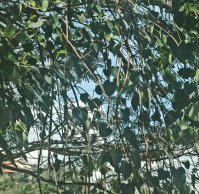Peepal
Botanical Name: Ficus religiosa
Indian Name: Peepal
Origin, Distribution and Composition
This is one of the best known trees of India. The tree grows to large proportions. It has a hard, cracked and greyish white bark and numerous offshoots.
Its leaves are somewhat leathery, broadly oval in shape, which suddenly narrow at the apex and into a long tail.
It is venerated by the Hindus and the Buddhists. The Rishis of yore medicated under it.
It was beneath a Peepal that Gautam Buddha attained enlightenment, and that particular tree came to be called Bodhi, the *tree of wisdom*. In the popular Indian folkore, this tree is considered as the female to the male banyan.
The tree is found wild in the forests on the lower slopes of the Himalayas, Orissa and in Central India. It grows wild in most parts of India, especially on the banks of rivers and lakes.
Healing Power and Curative Properties of Peepal
The bark and leaves of the tree are useful in many common ailments. Its leaves are laxative and a tonic. They relieve feverish feeling and produce a feeling of coolness.
They are also useful in arresting secretion or bleeding-about 50 ml of raw juice of the leaves or 1 teaspoon of powdered dried leaves can be taken with water in such cases.
Heart Diseases
The leaves of the herb are used in the treatment of heart diseases. They are infused in water at night, distilled the next morning and then stored in white bottles.
About 15 mg of this infusion is administered thrice daily. It is highly effective in relieving palpitation of the heart and cardiac weakness.

Constipation
The leaves of the tree are useful in constipation. They should be dried in the shade and powdered. Pills can be prepared by adding the required quantity of a solution of aniseed and jaggery with water. One pill taken with warm milk at bedtime ensures proper bowel movement the following morning.
Likewise, its fruits can be dried in shade, powdered and mixed with an equal quantity of sugar. This compound in doses of 4 to 6 grams, taken at bedtime with milk, serves the same function.
Dysentery
Its leaves are very effective in treating dysentery. Equal parts of peepal leaves, corriander leaves and sugar are chewed slowly to relieve the condition.
Bruises
Its leaves are also useful in bruises and wounds. They are ground fine, mixed with 25 grams of jaggery and made into 8 pills. One pill taken daily with milk can also relieve pain due to injury.
Scrofula
In Ayurveda, the tree grown on a cemented wall, with its roots still in the masonry and not reaching the ground-is a specific for scrofula- a serious disease of the neck, characterized by swollen lymphatic glands of the region.
A plaster-like paste prepared by rubbing its root with water can be applied on the glands of the affected people.
Mumps
The leaves are used in the treatment of mumps. They should be smeared with ghee, warmed over a fire, and bandaged over the inflamed part to get relief.
Boils
The leaves are also used in boils, A leaf smeared with ghee can be bandaged lukewarm on the boil. If there is any pus formation, it will burst, if it is in preliminary stages, the growth will subside.
Other Uses
A popular remedy for excessive urine output among jaundice patients is to soak a piece of tender bark of the tree in water overnight and allow the water to be taken the following morning.
Its fruits dried in shade and powdered are helpful in sexual disorders like spermatorrhoea, nocturnal emissions, and premature ejaculations.
Return from this Page to List of herbs



